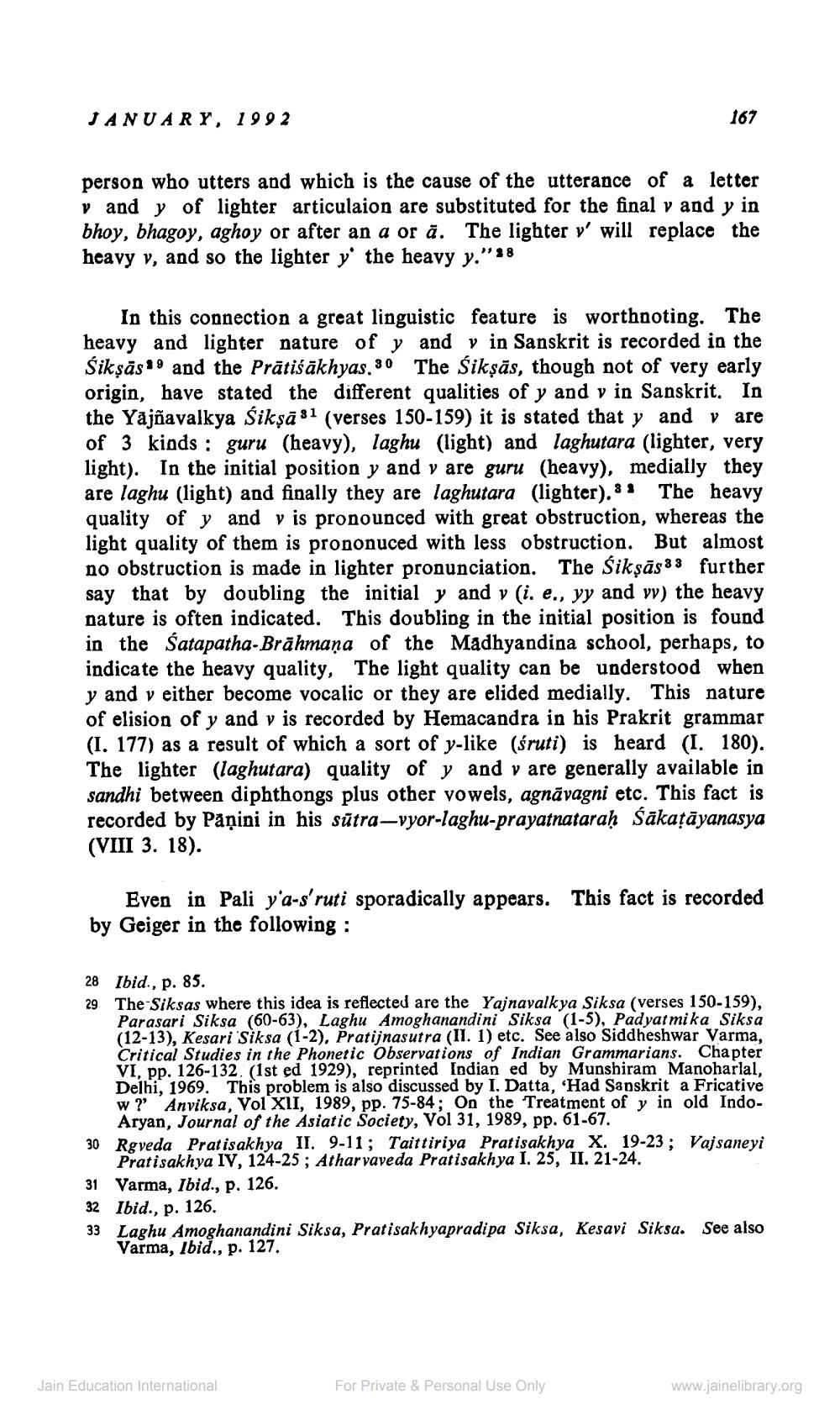________________
JANUARY, 1992
person who utters and which is the cause of the utterance of a letter v and y of lighter articulaion are substituted for the final v and y in bhoy, bhagoy, aghoy or after an a or a. The lighter v' will replace the heavy v, and so the lighter y' the heavy y.' "28
167
2
In this connection a great linguistic feature is worthnoting. The heavy and lighter nature of y and v in Sanskrit is recorded in the Šikṣās and the Prātiśākhyas. 30 The Sikṣās, though not of very early origin, have stated the different qualities of y and v in Sanskrit. In the Yajnavalkya Sikṣā 31 (verses 150-159) it is stated that y and v are of 3 kinds: guru (heavy), laghu (light) and laghutara (lighter, very light). In the initial position y and v are guru (heavy), medially they are laghu (light) and finally they are laghutara (lighter). 31 The heavy quality of y and v is pronounced with great obstruction, whereas the light quality of them is prononuced with less obstruction. But almost no obstruction is made in lighter pronunciation. The Sikṣās 33 further say that by doubling the initial y and v (i. e., yy and vv) the heavy nature is often indicated. This doubling in the initial position is found in the Satapatha-Brāhmaṇa of the Madhyandina school, perhaps, to indicate the heavy quality, The light quality can be understood when y and v either become vocalic or they are elided medially. This nature of elision of y and v is recorded by Hemacandra in his Prakrit grammar (I. 177) as a result of which a sort of y-like (śruti) is heard (I. 180). The lighter (laghutara) quality of y and v are generally available in sandhi between diphthongs plus other vowels, agnavagni etc. This fact is recorded by Panini in his sūtra-vyor-laghu-prayatnataraḥ Śākaṭāyanasya (VIII 3. 18).
Even in Pali y'a-s'ruti sporadically appears. This fact is recorded by Geiger in the following:
28 Ibid., p. 85.
29 The Siksas where this idea is reflected are the Yajnavalkya Siksa (verses 150-159), Parasari Siksa (60-63), Laghu Amoghanandini Siksa (1-5), Padyatmika Siksa (12-13), Kesari Siksa (1-2), Pratijnasutra (II. 1) etc. See also Siddheshwar Varma, Critical Studies in the Phonetic Observations of Indian Grammarians. Chapter VI, pp. 126-132. (1st ed 1929), reprinted Indian ed by Munshiram Manoharlal, Delhi, 1969. This problem is also discussed by I. Datta, 'Had Sanskrit a Fricative w?" Anviksa, Vol XII, 1989, pp. 75-84; On the Treatment of y in old IndoAryan, Journal of the Asiatic Society, Vol 31, 1989, pp. 61-67.
30 Rgveda Pratisakhya II. 9-11; Taittiriya Pratisakhya X. 19-23; Vajsaneyi Pratisakhya IV, 124-25; Atharvaveda Pratisakhya I. 25, II. 21-24.
31 Varma, Ibid., p. 126.
32 Ibid., p. 126.
33 Laghu Amoghanandini Siksa, Pratisakhyapradipa Siksa, Kesavi Siksa. See also Varma, Ibid., p. 127.
Jain Education International
For Private & Personal Use Only
www.jainelibrary.org




